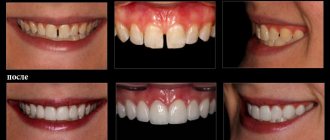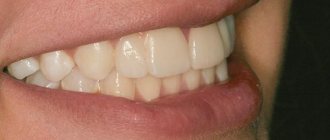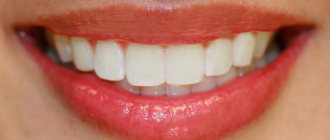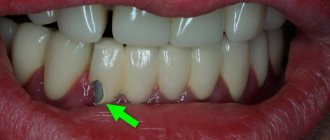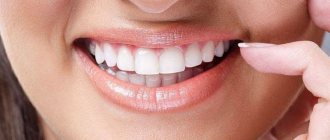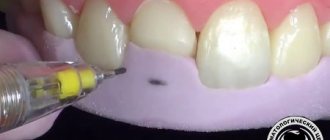Home / Articles / Broken tooth – what to do
Dental injuries are not uncommon in childhood. Children's activity takes its toll. Having discovered a defect, parents wonder what to do if their child has a broken tooth. An unpleasant situation can happen for various reasons. This often occurs due to weakened enamel. Part of a child's tooth can break off at the most inopportune moment, for example, when the baby bites off something hard.
The front teeth are at greatest risk. Because of this, the smile deteriorates. Pediatric dentistry today allows you to find a solution regardless of the complexity of the problem. In most cases, a broken tooth can be restored. For this purpose, modern techniques and the latest technologies are used.
See types and prices for dental prosthetics
Causes of dental injury
A large or barely noticeable gap in the teeth area spoils the entire appearance. To treat and restore a tooth, you need to know the main causes of dental injury. There are several of them.
1. Mostly, children receive mechanical injuries from a fall or bruise, when parents see, for example, that a front tooth has broken at the root.
2. Children's teeth are not yet strong enough to experience serious jaw load. Therefore, it is worth making sure that children do not get used to, for example, clenching their teeth tightly.
3. If half of the tooth crown is broken, it is due to a poor-quality filling.
4. The filling or inlay may pop out or break when it reaches the end of its service life.
5. Teeth with thinned enamel become a risk area.
6. Due to thinned enamel, the tooth may be destroyed due to carious formation.
7. The quality and properties of food also affect tooth decay.
Avoid giving children foods that are too hard or rough. Even seeds can cause a piece of a tooth to break off. To avoid all these unpleasant consequences, you will need to pay more attention to care, as well as the quality of food.
To strengthen tooth enamel, you need a sufficient amount of calcium in the body. To strengthen the structure, remineralization is required. The appearance of microcracks is due to the fact that the child receives food that is too contrasting. This affects the condition of the enamel, it becomes vulnerable. A weakened tooth may break at some point. This is the result of exposure to food and ingestion of hot and frozen drinks.
How do you know when it's time to see a doctor?
Tooth enamel hypoplasia is a disease that is difficult to miss. The child has the following symptoms:
- Deterioration of the enamel. The top layer of teeth becomes thinner and cracks appear on it;
- A carious layer appears on the teeth;
- The baby suffers from tooth sensitivity: he reacts to cold, hot, sweet.
Despite the fact that tooth enamel is the strongest tissue in the body, it cannot regenerate on its own. If symptoms of thinning are detected, parents should consult a doctor with their baby as soon as possible.
Typology of dental trauma
If a piece of a tooth breaks, the fragments can trap the enamel when destroyed. In these cases, the tooth breaks open or closed, and the pulp may open. Tooth injuries are distinguished by the area of the fracture - at the root, on top, etc. In case of injury, when a piece may break off, the tooth is often displaced.
The nature of the damage depends on the size of the chipped part, for example, if a child’s upper wisdom tooth is half broken:
- minimal degree of injury;
- average degree of injury;
- severe degree of injury.
When a tooth is damaged, the enamel is often affected. This is a minimal type of injury when the internal layers are not affected. The opposite indicates the average severity of the tooth fracture. In such a situation, the damage touches the pulp and the nerve is affected.
Let's look at the main types of dental damage. This is important for understanding what to do if a piece of a tooth breaks off.
1. The tooth broke in the root zone . The child’s tooth root is not yet strong enough to be difficult to remove.
The greatest risk, as always, falls on the upper front incisors. In order to determine why a child’s baby tooth has broken off, modern diagnostics will be required. A tooth fracture in the root area is determined by a series of x-rays. It is detected, as a rule, with the appearance of characteristic sensations due to inflammation of the gums. Depending on the degree of root destruction, the pulp will be affected, and this already leads to more serious consequences.
2. If a front tooth breaks off, and it is a baby tooth . Most often, a small piece breaks off from a small tooth. This can happen for various reasons. The doctor will determine the degree of danger. If the crown under the root is broken, the tooth will have to be removed. When a tooth chips away from the root, cosmetic restoration can be used to solve the problem. Usually the dentist performs extensions.
Often a tooth is displaced or dislocated as a result of a side blow to the jaw. For example, a child hit something when falling or another child accidentally touched it, and your child’s front tooth broke off. As a result, gum swelling may occur. The entry of microbes into the wound leads to the loss of a tooth, even if it is a milk tooth. It can be restored, but to do this it must be preserved in warm milk or saline until the implantation procedure.
Restoration of injured central incisors in children
Injuries to the anterior teeth of the upper jaw are a common occurrence in children. There are several ways to treat this problem. The consequences of this type of injury can vary from a simple crack to complete avulsion of the tooth. It depends on the severity and nature of the injury. Causes of injury may include playground incidents, fights, or falls. In modern aesthetic dentistry, restorations of the anterior teeth cause the greatest difficulties.
There are several ways to treat and restore chipped front teeth. The choice depends on the dentist's point of view and his knowledge in the field of aesthetic dentistry. In recent years, significant progress has been made in the field of aesthetics and physical properties of composite materials.
Thanks to this, as well as improved techniques such as layering techniques, dentists are now able to imitate the natural appearance of the dentition with direct esthetic restorations. A wide range of enamel shades has also been created, giving dentists the ability to control the degree of translucency and opacity of these types of restorations during minimally invasive procedures. The preserved tooth fragment can be used for its restoration. In this case, a good aesthetic result is achieved.
Today, dentists can perform restorations and achieve aesthetic results using bonding techniques. If the crack is close to the pulp or the pulp is exposed, the dentist may perform endodontic treatment followed by the installation of a post and crown. You may opt for pulp capping with a crown, porcelain veneer, or direct composite restoration.
In children aged 7-8 years with mixed dentition, large pulp canals with open apices are often found. This is explained by the incompleteness of the development of the dentition. At this stage, the occlusal plane, as well as the position of the teeth and soft tissues, are unstable. They are at the stage of formation. Once completed, it is expected that ideal treatment can be carried out. Age is an important factor in choosing the optimal restoration method. If options exist, children should be treated conservatively until they reach an appropriate age.
Clinical case 1.
The patient, a 7-year-old boy, chipped one third of his incisor as a result of a fall (Figure 1). The father took the child to the family dentist. The treatment plan he proposed seemed overly aggressive to the man (as a child, he had a negative experience of dental treatment for a similar injury). Given his son's age, the man felt a more conservative approach was best. Father and son were referred to my clinic for consultation. The man provided one x-ray, as well as a chipped fragment of the 9th tooth in a plastic bag.
Photo 1. Photo before surgery
Photo 2. Smile before surgery, chipped 9th tooth.
Diagnostics.
Clinical examination and review of one periapical radiograph revealed no pulp exposure. A diastema was observed between teeth 8 and 9, with tooth 9 tilted towards the buccal surface. An examination of the bite revealed the absence of occlusal contacts between the anterior teeth of the upper and lower jaw. The final position of the teeth, bite plane and soft tissues have not yet formed. Therefore, treatment options have been limited to the most conservative, minimally invasive procedures. After examining and cleaning the fragment, it was installed in place. Checked compatibility. To stabilize the fragment while the bond formed, a mastic stent with vinyl polysiloxane was made (Photo 3).
Photo 3. Checking the compatibility of the fragment.
After taking scans and photographs, taking into account the age of the child, his father was offered the following treatment options:
* Restoration of a chipped tooth using a light-curing composite
* Making a ceramic veneer (at this age this method is not recommended due to the changing size of the tooth and the development of soft tissues)
* Reattachment of tooth fragment
Treatment plan.
Due to the absence of symptoms, treatment was started without anesthesia. The dentin of the tooth and the fragment was cleaned with pumice, washed and dried. The tooth and fragment were disinfected in a surgical scrub with 2% chlorhexidine gluconate for 60 seconds. They were then washed, placed in a 5% sodium hypochloride solution and washed again.
After this procedure, the surgical field was isolated with cotton swabs. To increase bond strength and minimize microleakage, a full etching technique was used. The dentin and enamel surfaces of the chip and tooth were etched separately for 15 seconds using Ultra-Etch (Ultradent; South Jordan, UT) 35% with phosphoric acid (Ultradent), rinsed, then dentin primer and adhesive (ClearFil SE Bond) were applied J. Morita; Irvine, California), thinned with a blower and light cured for 15 seconds. To stabilize the position of the fragment while the bond was being formed, a stent was placed on the lingual surface of the tooth. The liner and dual-cure composite activator (Insure, Cosmedent; Chicago, IL) were then mixed and a small amount applied to both surfaces. The fragment was put in place. Excess composite was removed using a brush. Photopolymerization was carried out for 30 seconds. The stent was carefully removed; the lingual surface was cured for 30 seconds; this was followed by facial and lingual curing for 60 seconds.
The effects of trauma to the front teeth can range from simple cracking to complete avulsion, depending on the severity and nature of the injury. To increase the bond strength and durability of these types of restorations in children, it is recommended to apply excess composite along the fracture line. In this case, as mentioned earlier, due to the lack of occlusal contact between the maxillary and mandibular anterior teeth, a layer of hybrid composite was applied a few millimeters above the fracture line towards the lingual edge of the incisor, followed by light curing. A thin layer of light-curing clear composite was applied to the facial fracture line (Figure 4).
Photo 4. The fragment after bonding.
Grinding and polishing.
To ensure natural anatomy and structure of the tooth, a transparent composite was applied to its facial surface. Natural gloss on the facial and lingual surfaces of the teeth was provided by polishing strips. Flexi Disks (Cosmedent) followed by composite polishing paste were used to polish the face surface. Ball-shaped finishing diamond burs (Brasseler; Savannah, GA) were used on the lingual surface to create the desired structure. Finishing discs (Cosmedent) were then used followed by the application of a composite polishing paste. Occlusion was checked using various jaw movements to correct unstable contacts. The result was extremely satisfactory for the patient and his parents. The patient was scheduled for a postoperative visit within a few weeks (Figure 5).
Photo 5. View after treatment.
Clinical case 2.
This 11-year-old boy came to the clinic with his mother for the restoration of one third of the 9th tooth (Photo 6). The cause of the injury was a fall in the shower. Unlike the first case, the fragment of tooth 9 was lost. The patient's mother's request was high-quality conservative restorative treatment to restore the teeth to their natural appearance. Thanks to the improvement of the composition of modern composite materials, clinicians have at their disposal a variety of shades that can be used to create aesthetic restorations.
Photo 6. Case 2, view before surgery, chipped tooth 9. The fragment is lost.
Photo 7. Case 2, view of the smile before surgery, chipped tooth 9.
Diagnostics.
Clinical examination revealed no signs or symptoms of TMJ syndrome or malocclusion. Radiographs and clinical examination revealed no pulp pathologies. A diastema with minimal restoration was observed between teeth 8 and 9. There were no signs of a fracture of the 8th tooth.
Treatment plan.
After a complete clinical examination, an alginate impression was made, from which a study model was made for a diagnostic wax-up. Due to the loss of the fragment, the patient was offered a composite restoration. Considering the boy’s age, restoring teeth with ceramic veneers was not the best option. The patient's parents approved the proposed treatment option.
Before restoration, the tooth was cleaned with pumice and disinfected with chlorhexidine. Then we selected shades of Renamel Microfil composite (Cosmedent) and a hybrid composite to restore enamel and dentin. For the initial preparation, a round-head diamond bur (Brasseler) was used with a 2-mm lingual reduction with a deep and long bevel of 2-3 mm along the borders of the facial and lingual surfaces. To increase adhesion strength and minimize microleakage, complete etching was performed. The labial and lingual surfaces were etched for 15 seconds with 37% phosphoric acid, followed by 10 seconds of rinsing and drying. Clearfil SE-BOND adhesive (Kurary America, New York, NY) was applied to the facial and lingual surfaces. The material was then air thinned and light cured according to the manufacturer's instructions. To restore the lost fragment, a three-increment technique (dentin-enamel-incisor [Cosmedent]) was used. Renamel hybrid composite shade B1 was used to restore the lingual wall. To cover the edge of the bevel, a thin layer of opaque material was applied, followed by light curing.
Photo 8. Restoration of chipped tooth 9 with a composite material with microfiller.
Microfilled composite shade B1 was applied to the entire surface of the composite and tooth. An IPC spatula (Cosmedent) was used to create a random bevel and groove for the incisal composite. Then light curing was carried out. The groove is moistened using the composite, and compaction is carried out to ensure incisal transparency. Next comes curing.
Grinding and polishing.
The surface texture and final shape and function of the restoration are achieved through careful grinding and polishing. In this case, discs, crowns and contacts were used separately. Final polishing was carried out using a composite polishing paste (Cosmedent). The finished restoration looked like a real tooth (Photo 9).
Photo 9. Enlarged view of the finished restoration.
Conclusion.
Provided that the fragment is preserved and its integrity, it is possible to bond a chipped front tooth of the upper jaw with excellent results. In a short time, the fragment can be disinfected and secured in place using a dual-cure composite (Case 1). In cases of chip loss where a significant portion of the tooth is intact, conservative restorative treatment with direct esthetic composite as described in Case 2 is possible and is usually an excellent option for young patients (Figures 10 and 11).
Photo 10. View after surgery.
Photo 11. View after surgery.
Author: Khalil S. Saghezhi, DDS
Now let's consider another situation. A wisdom tooth chipped into the gums - what to do?
If a tooth breaks or falls out, do not treat the area with peroxide, alcohol, touch the wound, or brush with a toothbrush. In a situation where there is a suspicion of not just a broken tooth, but also a broken jaw, she needs to be provided with peace and immobilized. To do this, you will need to make a bandage passing through the top of the head.
Severe trauma to the jaw can lead to nosebleeds. In this case, it is necessary for the child to lower his head and place a cold compress on the bridge of his nose. At the same time as these actions, someone should call the doctor.
After identifying the nature of the damage in the hospital using an X-ray, it will be possible to determine how damaged the surrounding tissues are, whether there are dislocations or subluxations.
Types of chips
The complexity of damage is classified by degree:
- Incomplete if a crack or scratch has formed;
- Superficial – a chip affecting the enamel;
- Deep, causing damage to the base of the tooth, when the internal part is injured, without involving the nerve; reason – too much exercise, solid food;
- Chips exposing the pulp.
The formation of a chip is a reason to visit the dentist to prevent infection and carry out restorative measures.
Fortunately, modern dentistry can correct the situation.
What to do before visiting the dentist:
- Rinse with water - tooth fragments need to be removed; in the future, you can use an antiseptic or salt solution to reduce the risk of infection;
- Using a compress for swelling: if soft tissues are damaged or bleeding occurs, apply ice or a gauze compress with cold water;
- Before visiting a doctor, avoid solid, cold and warm foods;
- The appearance of throbbing pain indicates nerve involvement - an analgesic can be taken.
PROMOTION
Hygienic teeth cleaning
2000 rub.
Possible complications
Complex injuries can often have serious consequences, manifested in complications. It doesn’t matter which tooth was injured – the front incisor, the chewing tooth. After the examination, the doctor will decide how to save the child’s tooth. If you neglect the recommendations of a specialist, this can lead to more serious consequences, not to mention aesthetics.
Types of complications
1. Possibility of infection of the pulp area.
2. Increased tooth sensitivity.
3. The appearance of a bend in the tooth root.
4. Violation of occlusion.
5. Formation of cysts and granulomas.
You need to prepare for the fact that a damaged child’s tooth will begin to change the angle of development. And this leads to deformation not only of the damaged tooth, but also of its healthy neighbors. If it is necessary to remove a broken tooth, the space must be filled with an implant. If filling is not carried out, other teeth will begin to shift and move closer together, which leads to occlusion disorders - bite.
What are the dangers of dental injuries?
Tooth decay is associated with damage to internal tissues. If caries is not treated in time, damage to the pulp - the core of the tooth with the presence of nerves and blood vessels - will occur. And then – the inflammatory process. The child will begin to feel constant toothache and complain about his health. The inflammatory process will affect different areas. In children, pulp periodontitis develops due to inflammation. This is due to the fact that the roots of a child’s tooth develop and strengthen over a long period of time, so damage occurs faster.
How to restore a damaged area?
A child with a chipped tooth should be taken to the dentist immediately. The doctor will fill the canals in the exposed pulp and remove the nerve bundle. In general, different methods and technologies are used today to restore and preserve teeth.
- For a broken tooth, dental crowns are used.
- The doctor can place veneers for children.
- When a tooth is broken or chipped, your doctor may place baby inlays.
The use of a crown is advisable when a tooth in the upper row of incisors is broken or when the chewing teeth are damaged. But at the same time, processing (grinding) is carried out on neighboring ones.
You can restore your front teeth thanks to thin onlays - veneers, which can be matched to the rest of your teeth. If a tooth is broken and cannot be restored, the doctor will clean the canals and install an inlay (implant).
With the help of intracanal pins, it is possible to restore a chipped tooth if the parents decided to save it. With this method of dentures, aesthetics are preserved as much as possible. The operation will not affect the bite or chewing function.
Prevention of tooth decay
We must try to avoid serious dental problems and prevent situations where a child could be injured or break a tooth. Parents should try to minimize all risks. To do this, it is enough to apply a few simple rules in practice.
For proper growth and development of bones and teeth, it is necessary to provide the child with complete, high-quality nutrition. Then the body will receive the entire complex of necessary micronutrients, vitamins, and substances.
When the baby has all his milk teeth, around the age of three, it would be good to give him more solid food. Various vegetables, fruits, and crackers are suitable for this. This way the child will become accustomed to more adult food, which will strengthen his teeth.
To maintain healthy teeth, you need to pay attention to the development of the child’s chewing muscles; for this, you should control the consistency of food.
It is important to teach your child to brush his teeth and instill the good habit of visiting the dentist periodically.
View prices
Making an appointment with a dentist
When should you go to the dentist?
Immediately after receiving an injury, parents need to pull themselves together and try to calm the baby. The first thing you need to do is make a visual inspection, try to carefully clean the oral cavity from food debris, ask the child to rinse his mouth with boiled water at room temperature or a light antiseptic solution. To relieve the pain a little and reduce swelling, you can apply ice wrapped in several layers of napkins to the cheek on the side of the sore spot. If bleeding occurs, apply a piece of sterile bandage to the wound and immediately go to the doctor.
The first step is to ask your child to rinse his mouth.
